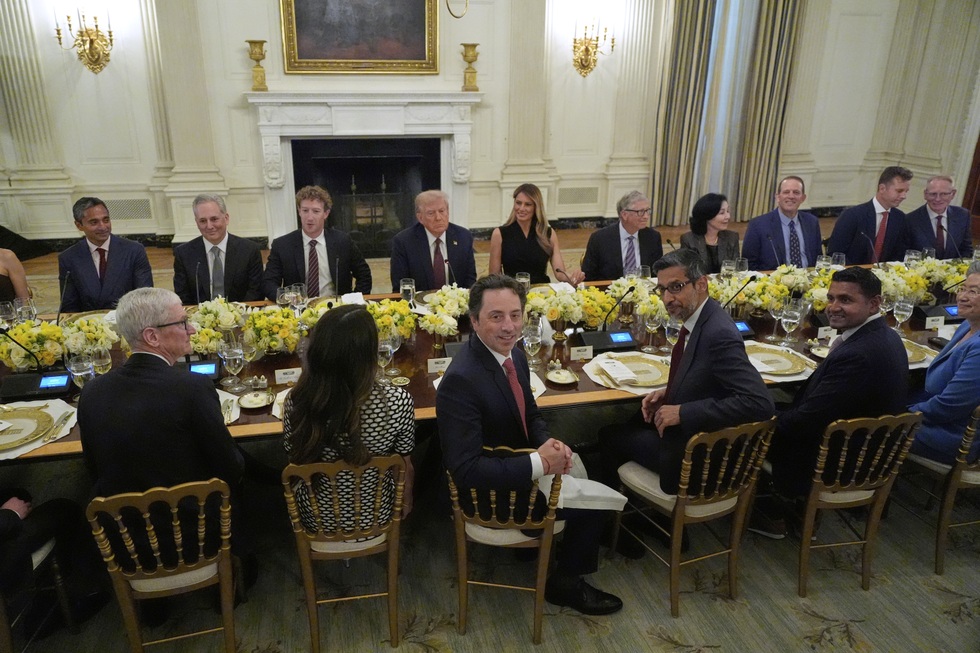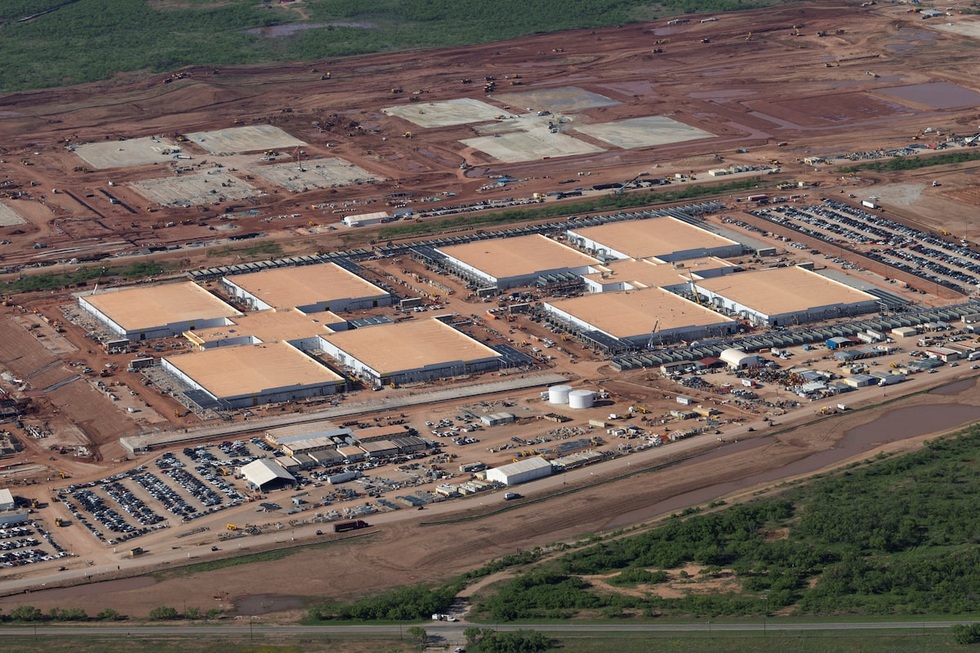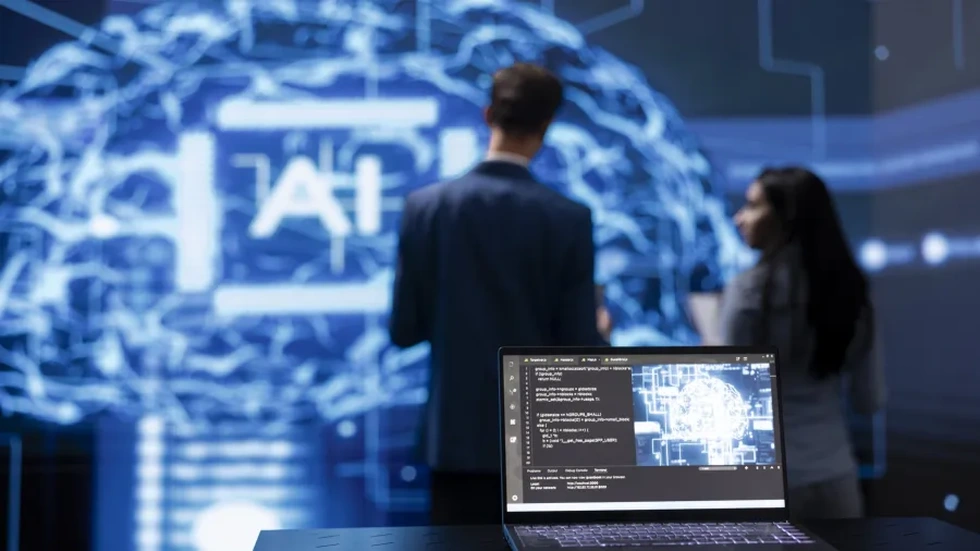On September 4, the White House became the center of global attention when President Donald Trump hosted a dinner with more than 30 of the world's top technology leaders.
The event is not only of diplomatic significance but also clearly demonstrates Washington's vision in promoting artificial intelligence (AI) as a strategic driver for US economic growth, security and international standing.

President Trump dined with representatives of leading US corporations (Photo: The Boston Globe).
Three pillars of global ambition
In July, the US government announced America's AI Action Plan - a document considered the foundation for national AI development orientation.
The plan revolves around three main pillars, with more than 90 specific actions, reflecting the ambition to maintain global technology leadership.
Fostering innovation is the first pillar. The Trump administration has pledged to remove what it sees as unnecessary barriers to AI companies and encourage experimentation in a “regulatory sandbox.”
AI systems are being developed in a flexible manner, reducing administrative procedures, promoting open source models and expanding access to government data for research. Some policies that were previously considered too restrictive are also being adjusted.
Building AI infrastructure is the second pillar. Washington aims to accelerate data center construction, expand domestic semiconductor production and secure energy supplies for AI facilities.
In July, an executive order was signed to streamline federal permitting for large-scale data center projects.
The U.S. Department of Energy selected four strategic sites for infrastructure construction, including the Idaho National Laboratory and the Oak Ridge Preserve.
In addition, the government offers various forms of financial support such as loan guarantees, tax incentives and pre-purchase agreements to attract businesses.
Diplomacy and international security are the third pillar. The US emphasizes its leading role in deploying AI technology globally, while focusing on protecting cybersecurity and preventing the risk of AI being exploited for malicious purposes. An AI-Intelligence Information Sharing Center (AI-ISAC) has been established to coordinate risk detection and response.
The plan is not only technologically oriented but also has strategic implications: AI is seen as the foundation for ensuring America's economic, scientific and defense competitiveness for decades to come.
Public-private partnerships and multi-billion dollar projects
A notable feature of technology policy under President Trump is the strong connection between the White House and major technology corporations. The September 4 dinner is seen as a symbol of this public-private partnership model.
Among the guests were Mark Zuckerberg (Meta), Tim Cook (Apple), Sundar Pichai (Google), Satya Nadella (Microsoft), Bill Gates (Microsoft), Sam Altman (OpenAI) and Larry Ellison (Oracle).
The gathering of many top leaders is likened to a "technology summit" under the roof of the White House.
One such project is Project Stargate, a $500 billion joint venture between OpenAI, SoftBank, Oracle, and MGX that focuses on building AI infrastructure, with the first of several data centers located in Texas.
The project is considered an important step forward to help the US proactively develop strategic infrastructure and reduce dependence on external supply chains.

A data center infrastructure within Project Stargate is under construction (Photo: Reuters).
In addition to Stargate, many businesses also announced large investments in the US.
Meta, Apple, Google, and Microsoft have all announced plans worth tens to hundreds of billions of dollars for AI infrastructure, data centers, and chip manufacturing. The US government has said this influx of capital is a testament to the private sector’s confidence in the new technology policy.
However, experts also note that the announced figures may represent long-term commitments, requiring time to evaluate actual effectiveness. At the same time, massive investment in data centers poses challenges in energy consumption and environmental protection - factors that require balance in policy.
Challenges, debates and long-term vision
Along with the bold moves, America's technology strategy under President Trump has also been controversial.
Some policy adjustments such as reducing requirements on diversity, equity, and inclusion (DEI) or cutting incentives for renewable energy have caused controversy. Scholars warn that if the US focuses only on liberalization, it may ignore aspects of social and environmental responsibility.
The huge energy demands of AI also put huge pressure on the national power grid.
Relations between the White House and some tech entrepreneurs have not always been smooth. Elon Musk's absence from the September 4 dinner was seen by observers as a symbol of disagreements within the US tech community.

Leading US technology corporations have pledged to invest hundreds of billions of dollars in AI in the coming years, including cooperation to build data centers (Illustration photo: ST).
However, from a strategic perspective, the Trump administration sees AI as the “key” to opening a new era of growth. From healthcare, education to defense, AI is expected to bring breakthroughs.
US tech giants also highlight the potential of AI in developing personalized vaccines, managing smart infrastructure and expanding space exploration.
For the workforce, the White House promotes AI skills training programs in collaboration with businesses. First Lady Melania Trump is recognized for actively participating in educational activities, encouraging the responsible application of AI.
Internationally, the US AI strategy reflects the global competitive landscape. China, the European Union, Japan and India are all accelerating their investments. In this context, Washington asserts its goal of not only “leading” but also shaping global technological standards.
The biggest problem facing the United States today is maintaining balance: between innovation and responsibility, between growth and sustainability, between competition and international cooperation.
The AI Action Plan, along with mega-projects like Project Stargate, offer a clear vision for building infrastructure and attracting investment. But challenges in energy, the environment, governance, and social trust will determine how successful this strategy is.
The White House dinner is a symbol of a new era: the government and big tech companies are joining forces to make AI the engine of national development. The future of the global tech race will depend largely on how the United States realizes this ambition.
Source: https://dantri.com.vn/cong-nghe/hoa-ky-va-tham-vong-dinh-hinh-ky-nguyen-ai-20250927074015283.htm


![[Photo] High-ranking delegation of the Russian State Duma visits President Ho Chi Minh's Mausoleum](https://vphoto.vietnam.vn/thumb/1200x675/vietnam/resource/IMAGE/2025/9/28/c6dfd505d79b460a93752e48882e8f7e)


![[Photo] The 4th meeting of the Inter-Parliamentary Cooperation Committee between the National Assembly of Vietnam and the State Duma of Russia](https://vphoto.vietnam.vn/thumb/1200x675/vietnam/resource/IMAGE/2025/9/28/9f9e84a38675449aa9c08b391e153183)
![[Photo] Joy on the new Phong Chau bridge](https://vphoto.vietnam.vn/thumb/1200x675/vietnam/resource/IMAGE/2025/9/28/b00322b29c8043fbb8b6844fdd6c78ea)





























































































Comment (0)